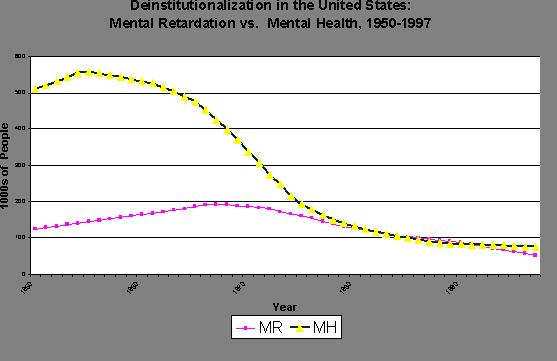Deinstitutionalization in Developmental Disabilities Must be Clearly Differentiated from Deinstituti
Many people, including national radio and television commentators, have failed to recognize this fact:
Deinstitutionalization of people with developmental disabilities in America has been one of the most successful and cost-effective social experiments in the past three decades.
I believe the misunderstanding is largely due to the confusion of mental health/mental illness with mental retardation. State institutions for mental illness have experienced an entirely different, and devastatingly negative, depopulation movement (Bassuk & Gerson, 1978, Scientific American). The graph below contrasts the depopulation of mental health institutions against the deinstitutionalization of public institutions for people with mental retardation.

Deinstitutionalization of people with mental illness was done hastily, without supports, and largely with reliance on the "new miracle drugs" approved by the FDA in 1955 (the chlorpromazine derivatives, including Haldol, Mellaril, Thorazine, and so on). The phrase “dumping” came from the fact that tens of thousands of people were simply "discharged" with 30 days of "miracle drug" with no place to live, no job or day activity, and no support to reestablish family relationships. This policy was led by policy makers in California during the 1960s and 1970s. The policy continued and spread to other states as a “solution” to overcrowded institutional settings that were unable to deliver adequate clinical services. The result has been a national disgrace, including a major portion of the problem called "homelessness" (Alexander, 1996). As Alexander wrote,
Following the deinstitutionalization of persons with serious mental illness from state hospitals, many persons with serious mental illness did not receive the care that they needed and encountered unexpected negative experiences. Among the negative experiences were frequent rehospitalizations, involvement in the criminal justice system, and homelessness.
I believe that it is absolutely essential that the court understand the stark difference between the national record in mental health versus that for mental retardation and developmental disabilities.
In the case of people with developmental disabilities, moving from large institutions to small community homes has been extremely successful.